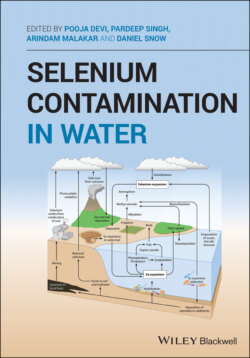Читать книгу Selenium Contamination in Water - Группа авторов - Страница 59
4.3.2 Sheep
ОглавлениеOral selenite exposure with 50 mg Se/day in sheep caused death after exposure for 72 days. Postmortem reports determined that lesions were observed in heart and lungs (Glenn et al. 1964a, 1964b). The seleniferous range caused severe eye deformation in growing lambs (Rosenfeld and Beath 1947). The erythrocytic lysis process was also reported after selenite exposure to sheep and this might explain the hematological changes in sheep due to chronic selenosis (Young et al. 1981).
Table 4.2 RDI of selenium ingestion for different animals.
Source: Adapted from Hosnedlova et al. (2017).
| Animal species | RDI of Se | References |
|---|---|---|
| Beef cattle | 100 μg/kg of FDM | National Research Council (NRC) (2001), Suttle (2010) |
| 0.20 mg/kg | McDowell (1992) | |
| Camel | 97–112 ng/ml | Zong‐Ping et al. (1994) |
| 25–53 ng/ml | Rahim (2005) | |
| Dairy cattle | 300 μg/kg of FDM | National Research Council (NRC) (2001), Suttle (2010) |
| 0.30 mg/kg | McDowell (1992) | |
| Donkeys | 2 mg/day | Geor et al. (2013) |
| 0.1–0.15 mg/100 kg BW | National Research Council (NRC) (2007) | |
| Goat | 0.1 mg/kg of FDM | Papazafeiriou et al. (2016) |
| Horses | 0.1 ppm of FDM | National Research Council (NRC) (2007), Pagan et al. (1999) |
| 0.10 mg/kg | McDowell (1992) | |
| Pigs | 0.15–0.30 mg/kg | Surai and Fisinin (2015) |
| Swine | 0.10–0.30 mg/kg | McDowell (1992) |
| Sheep | 0.1–0.2 mg/kg of FDM | National Research Council (NRC) (1985) |
| 0.10–0.20 mg/kg | McDowell (1992) |
BW – body weight; FDM – food dry matter; RDI – recommended daily intake.
Most of the studies indicated that toxicity in sheep and lambs was caused by 0.45–8 mg Se/kg LW (Caravaggi et al. 1970; Yaeger et al. 1998; Tiwary et al. 2006). Inorganic forms of Se caused toxicity in sheep and lambs. Giese (1984) found that most of the Se excreted via urine and feces after intravenous injection of high Se dose. The half‐life of Se in sheep is 14.7 days (Blodgett and Bevill 1987). Se toxicity in sheep and lamb caused respiratory problems, hair loss, cracks on hooves and horn, ataxia, and reduced feed intake. Myocardial necrosis and pulmonary alveolar vasculitis were found after exposing lambs with 8 mg Se/kg LW (Gupta et al. 1982; Tiwary et al. 2006).
